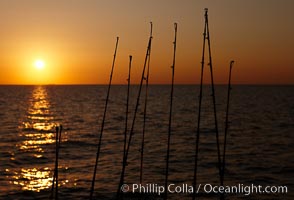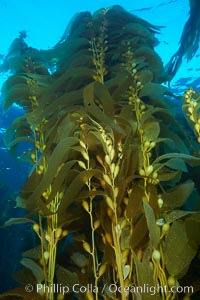
Kelp fronds and pneumatocysts. Pneumatocysts, gas-filled bladders, float the kelp plant off the ocean bottom toward the surface and sunlight, where the leaf-like blades and stipes of the kelp plant grow fastest. Giant kelp can grow up to 2' in a single day given optimal conditions. Epic submarine forests of kelp grow throughout California's Southern Channel Islands.
Species: Giant kelp, Macrocystis pyrifera
Location: San Clemente Island, California
Image ID: 23507
Species: Giant kelp, Macrocystis pyrifera
Location: San Clemente Island, California
Image ID: 23507
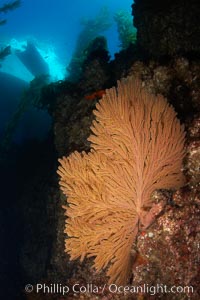
California golden gorgonian on rocky reef, below kelp forest, underwater. The golden gorgonian is a filter-feeding temperate colonial species that lives on the rocky bottom at depths between 50 to 200 feet deep. Each individual polyp is a distinct animal, together they secrete calcium that forms the structure of the colony. Gorgonians are oriented at right angles to prevailing water currents to capture plankton drifting by.
Species: California golden gorgonian, Muricea californica
Location: San Clemente Island, California
Image ID: 23508
Species: California golden gorgonian, Muricea californica
Location: San Clemente Island, California
Image ID: 23508
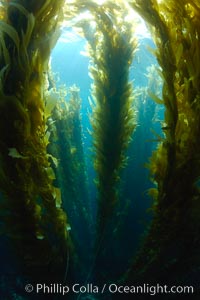
Kelp forest, underwater.
Species: Giant kelp, Macrocystis pyrifera
Location: San Clemente Island, California
Image ID: 23510
Species: Giant kelp, Macrocystis pyrifera
Location: San Clemente Island, California
Image ID: 23510
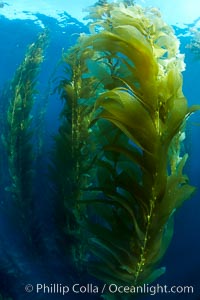
Kelp forest, underwater.
Species: Giant kelp, Macrocystis pyrifera
Location: San Clemente Island, California
Image ID: 23511
Species: Giant kelp, Macrocystis pyrifera
Location: San Clemente Island, California
Image ID: 23511
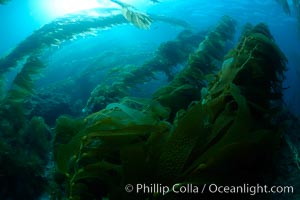
Kelp forest is swept back by ocean currents, underwater.
Species: Giant kelp, Macrocystis pyrifera
Location: Catalina Island, California
Image ID: 23512
Species: Giant kelp, Macrocystis pyrifera
Location: Catalina Island, California
Image ID: 23512
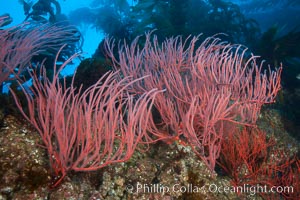
Red gorgonian, underwater. The red gorgonian is a filter-feeding temperate colonial species that lives on the rocky bottom at depths between 50 to 200 feet deep. Gorgonians are oriented at right angles to prevailing water currents to capture plankton drifting by.
Species: Red gorgonian, Leptogorgia chilensis, Lophogorgia chilensis, Macrocystis pyrifera
Location: San Clemente Island, California
Image ID: 23513
Species: Red gorgonian, Leptogorgia chilensis, Lophogorgia chilensis, Macrocystis pyrifera
Location: San Clemente Island, California
Image ID: 23513
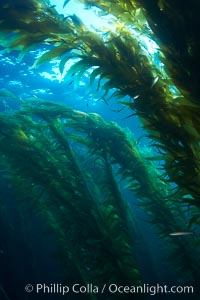
A kelp forest. Giant kelp grows rapidly, up to 2' per day, from the rocky reef on the ocean bottom to which it is anchored, toward the ocean surface where it spreads to form a thick canopy. Myriad species of fishes, mammals and invertebrates form a rich community in the kelp forest. Lush forests of kelp are found through California's Southern Channel Islands.
Species: Giant kelp, Macrocystis pyrifera
Location: San Clemente Island, California
Image ID: 23514
Species: Giant kelp, Macrocystis pyrifera
Location: San Clemente Island, California
Image ID: 23514
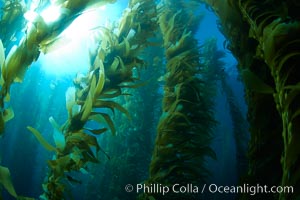
A kelp forest. Giant kelp grows rapidly, up to 2' per day, from the rocky reef on the ocean bottom to which it is anchored, toward the ocean surface where it spreads to form a thick canopy. Myriad species of fishes, mammals and invertebrates form a rich community in the kelp forest. Lush forests of kelp are found through California's Southern Channel Islands.
Species: Giant kelp, Macrocystis pyrifera
Location: San Clemente Island, California
Image ID: 23515
Species: Giant kelp, Macrocystis pyrifera
Location: San Clemente Island, California
Image ID: 23515
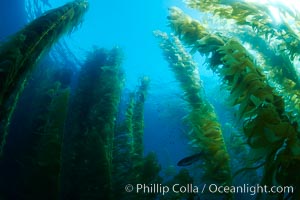
Kelp forest, underwater.
Species: Giant kelp, Macrocystis pyrifera
Location: San Clemente Island, California
Image ID: 23516
Species: Giant kelp, Macrocystis pyrifera
Location: San Clemente Island, California
Image ID: 23516
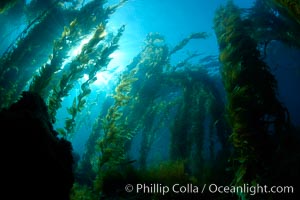
Kelp forest, sunlight filters through towering stands of giant kelp, underwater.
Species: Giant kelp, Macrocystis pyrifera
Location: Catalina Island, California
Image ID: 23517
Species: Giant kelp, Macrocystis pyrifera
Location: Catalina Island, California
Image ID: 23517
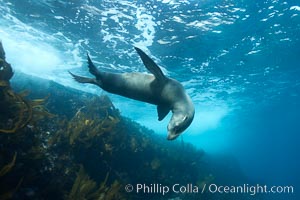
California sea lion, underwater at Santa Barbara Island. Santa Barbara Island, 38 miles off the coast of southern California, is part of the Channel Islands National Marine Sanctuary and Channel Islands National Park. It is home to a large population of sea lions.
Species: California sea lion, Zalophus californianus
Location: Santa Barbara Island, California
Image ID: 23518
Species: California sea lion, Zalophus californianus
Location: Santa Barbara Island, California
Image ID: 23518
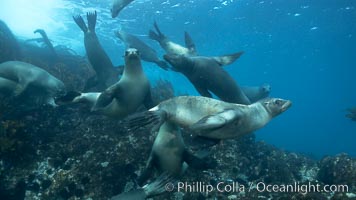
California sea lions, underwater at Santa Barbara Island. Santa Barbara Island, 38 miles off the coast of southern California, is part of the Channel Islands National Marine Sanctuary and Channel Islands National Park. It is home to a large population of sea lions.
Species: California sea lion, Zalophus californianus
Location: Santa Barbara Island, California
Image ID: 23519
Species: California sea lion, Zalophus californianus
Location: Santa Barbara Island, California
Image ID: 23519
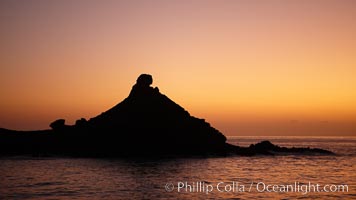
China Hat Point, San Clemente Island, sunrise.
Location: San Clemente Island, California
Image ID: 23556
Location: San Clemente Island, California
Image ID: 23556
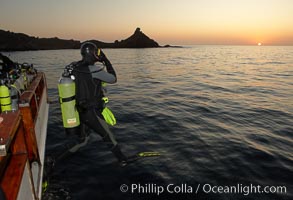
A SCUBA diver leaps into the water, from boat Horizon, into the kelp forest and rich waters of San Clemente Island, China Hat Point, Balanced Rock, sunrise.
Location: San Clemente Island, California
Image ID: 23557
Location: San Clemente Island, California
Image ID: 23557
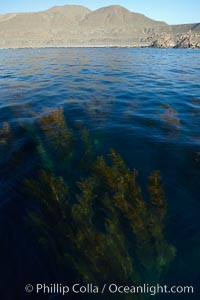
A forest of giant kelp, growing just below the ocean surface along the shores of San Clemente Island.
Species: Giant kelp, Macrocystis pyrifera
Location: San Clemente Island, California
Image ID: 23558
Species: Giant kelp, Macrocystis pyrifera
Location: San Clemente Island, California
Image ID: 23558
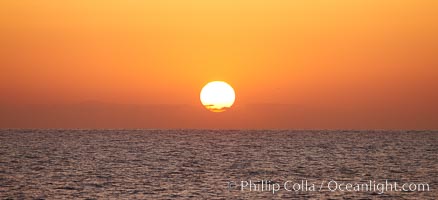
The sun rises over the Pacific Ocean offshore of California.
Location: Santa Barbara Island, California
Image ID: 23559
Location: Santa Barbara Island, California
Image ID: 23559
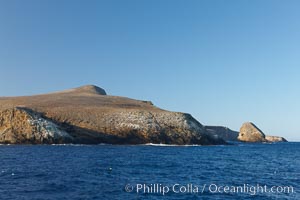
Northwest promontory of Santa Barbara Island, part of the Channel Islands National Marine Sanctuary. Santa Barbara Island lies 38 miles offshore of the coast of California, near Los Angeles and San Pedro.
Location: Santa Barbara Island, California
Image ID: 23561
Location: Santa Barbara Island, California
Image ID: 23561
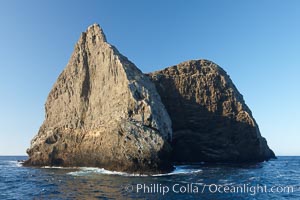
Sutil Island,a small barren island near Santa Barbara Island, part of the Channel Islands National Marine Sanctuary. Santa Barbara Island lies 38 miles offshore of the coast of California, near Los Angeles and San Pedro.
Location: Santa Barbara Island, California
Image ID: 23562
Location: Santa Barbara Island, California
Image ID: 23562
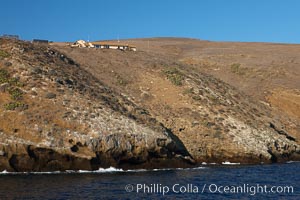
Western landing and National Park buildings on Santa Barbara Island, part of the Channel Islands National Marine Sanctuary. Santa Barbara Island lies 38 miles offshore of the coast of California, near Los Angeles and San Pedro.
Location: Santa Barbara Island, California
Image ID: 23563
Location: Santa Barbara Island, California
Image ID: 23563
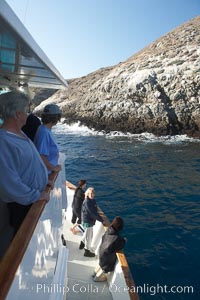
Visitors watch sea lions along the coast of Santa Barbara Island, part of the Channel Islands National Marine Sanctuary. Santa Barbara Island lies 38 miles offshore of the coast of California, near Los Angeles.
Location: Santa Barbara Island, California
Image ID: 23564
Location: Santa Barbara Island, California
Image ID: 23564
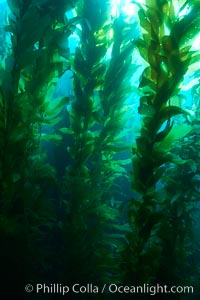
A kelp forest. Giant kelp grows rapidly, up to 2' per day, from the rocky reef on the ocean bottom to which it is anchored, toward the ocean surface where it spreads to form a thick canopy. Myriad species of fishes, mammals and invertebrates form a rich community in the kelp forest. Lush forests of kelp are found through California's Southern Channel Islands.
Species: Giant kelp, Macrocystis pyrifera
Location: San Clemente Island, California
Image ID: 23520
Species: Giant kelp, Macrocystis pyrifera
Location: San Clemente Island, California
Image ID: 23520
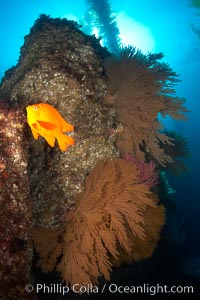
Garibaldi and California golden gorgonians on rocky reef, below kelp forest, underwater. The golden gorgonian is a filter-feeding temperate colonial species that lives on the rocky bottom at depths between 50 to 200 feet deep. Each individual polyp is a distinct animal, together they secrete calcium that forms the structure of the colony. Gorgonians are oriented at right angles to prevailing water currents to capture plankton drifting by.
Species: California golden gorgonian, Hypsypops rubicundus, Muricea californica
Location: San Clemente Island, California
Image ID: 23521
Species: California golden gorgonian, Hypsypops rubicundus, Muricea californica
Location: San Clemente Island, California
Image ID: 23521
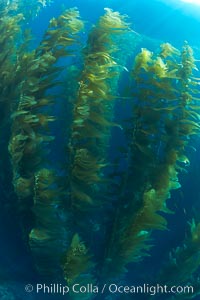
A kelp forest. Giant kelp grows rapidly, up to 2' per day, from the rocky reef on the ocean bottom to which it is anchored, toward the ocean surface where it spreads to form a thick canopy. Myriad species of fishes, mammals and invertebrates form a rich community in the kelp forest. Lush forests of kelp are found through California's Southern Channel Islands.
Species: Giant kelp, Macrocystis pyrifera
Location: San Clemente Island, California
Image ID: 23522
Species: Giant kelp, Macrocystis pyrifera
Location: San Clemente Island, California
Image ID: 23522
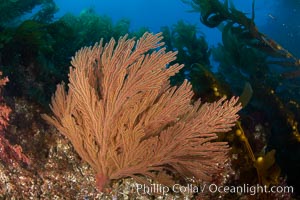
California golden gorgonian on rocky reef, below kelp forest, underwater. The golden gorgonian is a filter-feeding temperate colonial species that lives on the rocky bottom at depths between 50 to 200 feet deep. Each individual polyp is a distinct animal, together they secrete calcium that forms the structure of the colony. Gorgonians are oriented at right angles to prevailing water currents to capture plankton drifting by.
Species: California golden gorgonian, Macrocystis pyrifera, Muricea californica
Location: San Clemente Island, California
Image ID: 23523
Species: California golden gorgonian, Macrocystis pyrifera, Muricea californica
Location: San Clemente Island, California
Image ID: 23523
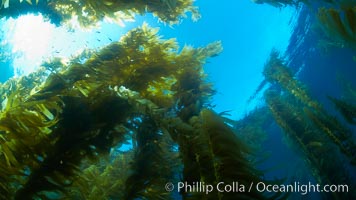
Giant kelp plants lean over in ocean currents, underwater. Individual kelp plants grow from the rocky reef, to which they are attached, up to the ocean surface and form a vibrant community in which fishes, mammals and invertebrates thrive.
Species: Giant kelp, Macrocystis pyrifera
Location: San Clemente Island, California
Image ID: 23524
Species: Giant kelp, Macrocystis pyrifera
Location: San Clemente Island, California
Image ID: 23524
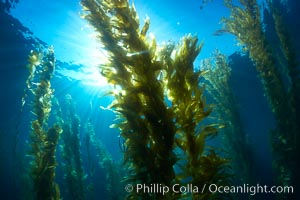
Giant kelp plants lean over in ocean currents, underwater. Individual kelp plants grow from the rocky reef, to which they are attached, up to the ocean surface and form a vibrant community in which fishes, mammals and invertebrates thrive.
Species: Giant kelp, Macrocystis pyrifera
Location: San Clemente Island, California
Image ID: 23525
Species: Giant kelp, Macrocystis pyrifera
Location: San Clemente Island, California
Image ID: 23525
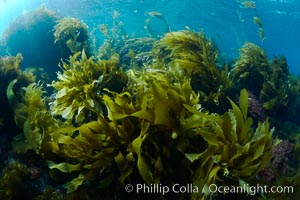
Southern sea palms, palm kelp, Marine algae, various species, in shallow water underwater.
Location: Catalina Island, California
Image ID: 23526
Location: Catalina Island, California
Image ID: 23526
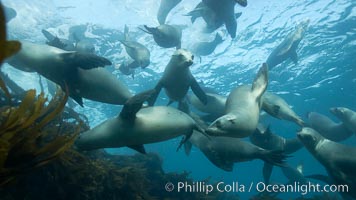
California sea lions, underwater at Santa Barbara Island. Santa Barbara Island, 38 miles off the coast of southern California, is part of the Channel Islands National Marine Sanctuary and Channel Islands National Park. It is home to a large population of sea lions.
Species: California sea lion, Zalophus californianus
Location: Santa Barbara Island, California
Image ID: 23527
Species: California sea lion, Zalophus californianus
Location: Santa Barbara Island, California
Image ID: 23527
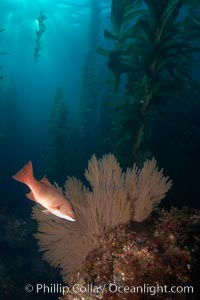
Sheephead and golden gorgonian, underwater in a kelp forest.
Species: California golden gorgonian, Muricea californica, Semicossyphus pulcher
Location: San Clemente Island, California
Image ID: 23528
Species: California golden gorgonian, Muricea californica, Semicossyphus pulcher
Location: San Clemente Island, California
Image ID: 23528
